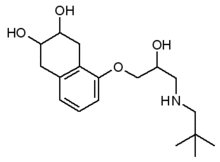Corgard
Nadolol (Corgard) is a non-selective beta-blocker used in the treatment of high blood pressure and chest pain. more...
Chemistry and pharmacokinetics
Nadolol is nonpolar and hydrophobic, with low lipid solubility. Its half-life is 14-24 hours.
Mechanism of action
Nadolol non-selectively blocks beta-1 adrenergic receptors mainly in the heart, inhibiting the effects of the catecholamines epinephrine and norepinephrine and decreasing heart rate and blood pressure. It also blocks beta-2 adrenergic receptors located in bronchiole smooth muscle, causing vasoconstriction. By binding beta-2 receptors in the juxtaglomerular apparatus, nadolol inhibits the production of renin, thereby inhibiting angiotensin II and aldosterone production. Nadolol therefore inhibits the vasoconstriction and water retention due to angiotensin II and aldosterone, respectively.
The drug impairs AV node conduction and decreases sinus rate.
Nadolol may also increase plasma triglycerides and decrease HDL-cholesterol levels.
Indications
Nadolol is indicated for treatment of moderate hypertension and chest pain. In patients with severe hypertension, nadolol can also treat reflex tachycardia due to treatment with vasodilators.
Contraindications
Patients whose heart rate is largely mediated by the sympathetic nervous system (e.g. patients with congestive heart failure or myocardial infarct) should avoid nadolol as it inhibits sympathetic function. Nadolol is also contraindicated in patients with bradycardia (slow heart rate) because of its vasodilatory effects and tendency to cause bradycardia.
Because of its beta-2 activity, nadolol causes pulmonary vasoconstriction and should be avoided in asthma patients in preference of a beta-1 blocker.
As nadolol, like other beta-2 blockers, inhibits the release of insulin in response to hypoglycemia, it slows patients' recovery from acute hypoglycemic episodes and should be avoided in some patients with diabetes mellitus. In patients with insulin-dependent diabetes, a selective beta-1 blocker is preferred over non-selective blockers.
Side effects
- Bradycardia
- Fatigue
- Bronchospasms
Read more at Wikipedia.org



